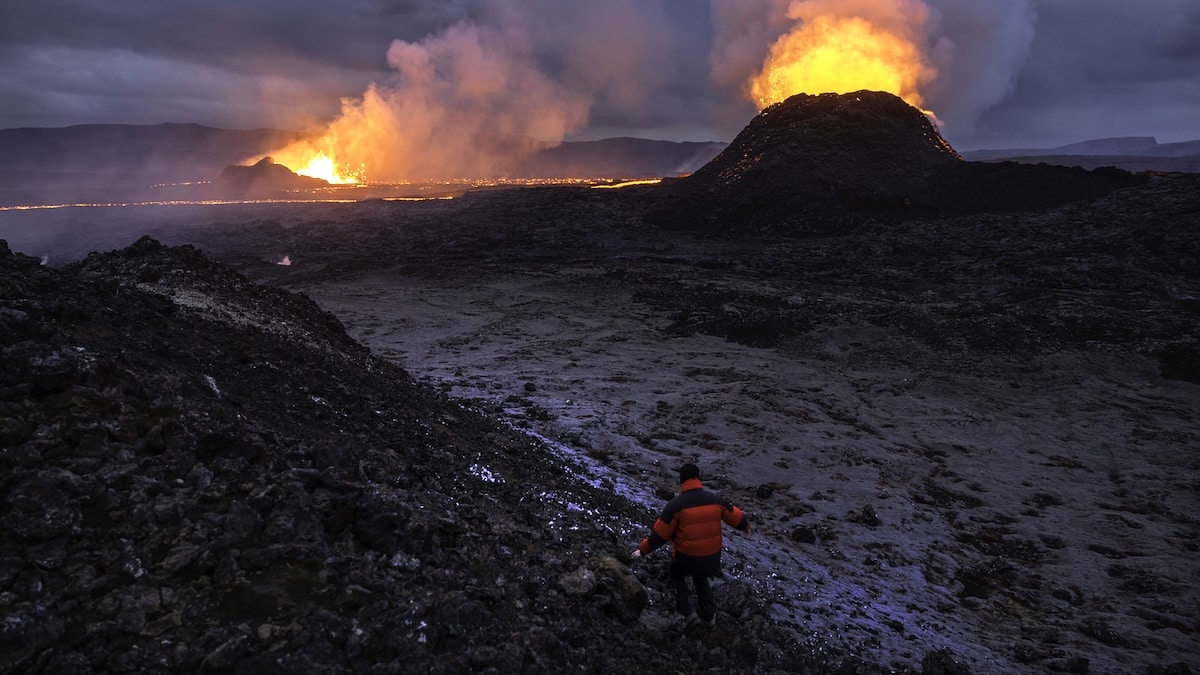A photographer approaches the craters of the active Sundhnúkur volcano on the Reykjanes peninsula near Grindavik, Iceland on June 2, 2024. John Moore / Getty Images
Why you can trust us
Founded in 2005 as an Ohio-based environmental newspaper, EcoWatch is a digital platform dedicated to publishing quality, science-based content on environmental issues, causes, and solutions.
Ice loss from melting glaciers around the world due to global heating could cause pressure to be released from volcanic magma chambers located deep underground.
The process — already seen in Iceland — makes volcanic eruptions more frequent and powerful, according to new research conducted in the Chilean Andes.
“As glaciers retreat due to climate change, our findings suggest these volcanoes go on to erupt more frequently and more explosively,” said lead author of the research Pablo Moreno-Yaeger, a graduate student at the University of Wisconsin-Madison, as The Guardian reported. “We found that following deglaciation, the volcano starts to erupt way more, and also changes composition.”
While eruptions are suppressed, magma melts crustal rocks, making the molten rock more viscous and setting the stage for it to be more explosive when it erupts.
Melting glaciers and ice caps could unleash wave of volcanic eruptions, study says
[image or embed]
— The Guardian (@theguardian.com) July 7, 2025 at 7:18 PM
“Glacial loading and unloading can impact eruptive outputs at mid- to high-latitude arc volcanoes, yet the influence on magma storage conditions remains poorly understood. Mocho-Choshuenco volcano in the Andean Southern Volcanic Zone has been impacted by the advance and retreat of the Patagonian ice sheet,” the authors of the study wrote.
The findings of the study were presented on July 8 at the Goldschmidt Conference in Prague. The research suggests that hundreds of subglacial volcanoes that have been dormant — especially in Antarctica — have the potential to become active as glacial retreat accelerates under climate change, a press release from the Goldschmidt Conference said.
Since the 1970s, scientists have been aware of the link between increased volcanic activity and retreating glaciers in Iceland. However, this is among the first studies to examine this type of event in continental volcanic systems.
The findings could help scientists better comprehend, as well as predict, volcanic activity in glacial regions.
To study how past volcanic behavior was influenced by the retreat and advance of the Patagonian Ice Sheet, the researchers used crystal analysis and argon dating across six Chilean volcanoes, including now-dormant Mocho-Choshuenco.
Melting glaciers may increase the frequency and explosiveness of volcanic eruptions, potentially impacting global climate as retreating ice reduces pressure on magma chambers beneath volcanoes.
[image or embed]
— Science X / Phys.org (@sciencex.bsky.social) July 7, 2025 at 7:02 PM
Through the analysis of erupted rock crystals and precisely dated earlier eruptions, the research team was able to track how the pressure and weight of glacial ice altered the characteristics of underground magma.
They discovered that thick ice cover at the peak of the last Ice Age roughly 26,000 to 18,000 years ago suppressed eruption volume, allowing a large silica-rich magma reservoir to accumulate 10 to 15 kilometers underground.
The sudden loss of weight from the rapidly melting ice sheet as the last Ice Age ended caused a relaxation of the crust and an expansion of gases in the magma. The pressure led to explosive volcanic eruptions deep within the reservoir, causing formation of the volcano.
“Glaciers tend to suppress the volume of eruptions from the volcanoes beneath them,” Moreno-Yaeger said. “The key requirement for increased explosivity is initially having a very thick glacial coverage over a magma chamber, and the trigger point is when these glaciers start to retreat, releasing pressure — which is currently happening in places like Antarctica.”
Moreno-Yaeger said the findings suggested the phenomenon wasn’t limited to Iceland, but could happen all over the world.
“Other continental regions, like parts of North America, New Zealand and Russia, also now warrant closer scientific attention,” Moreno-Yaeger said.
Although in geological terms the volcanoes’ response to glacial melt is almost instant, changes to the magma system are gradual, occurring over centuries, which provides some time for monitoring and warnings to be issued.
The team noted that an increase in volcanic activity could impact the whole planet. Eruptions release aerosols that can provide temporary cooling in the short-term. This was the case following the eruption of Mount Pinatubo in the Philippines in 1991. The explosion reduced global temperatures by roughly 0.5 degrees Celsius.
However, multiple eruptions have a reverse effect.
“Over time the cumulative effect of multiple eruptions can contribute to long-term global warming because of a buildup of greenhouse gases,” Moreno-Yaeger explained. “This creates a positive feedback loop, where melting glaciers trigger eruptions, and the eruptions in turn could contribute to further warming and melting.”
Subscribe to get exclusive updates in our daily newsletter!
By signing up, you agree to the Terms of Use and Privacy Policy, and to receive electronic communications from EcoWatch Media Group, which may include marketing promotions, advertisements and sponsored content.
